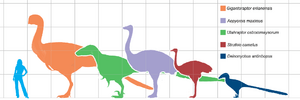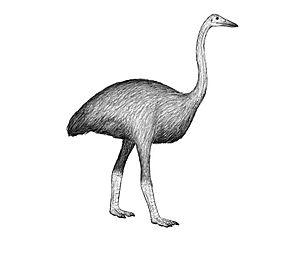Elephant bird facts for kids
Quick facts for kids Elephant birdsTemporal range: Quaternary
|
|
|---|---|
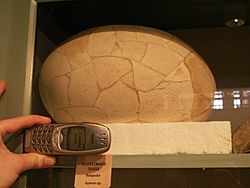 |
|
| The egg of an Elephant bird | |
| Scientific classification | |
| Kingdom: | |
| Phylum: | |
| Class: | |
| Order: |
Aepyornithiformes
A. Newton, 1884
|
| Family: |
†Aepyornithidae
(Bonaparte, 1853)
|
Elephant birds were a group of huge, flightless birds that are now extinct. They lived only on the island of Madagascar. There were two main types, Aepyornis and Mullerornis, with seven different kinds (species). Like many other birds that couldn't fly, they were hunted until they disappeared forever.
Contents
What Were Elephant Birds Like?
Elephant birds were giant ratites, which means they were a type of bird that couldn't fly and had a flat breastbone. They lived in Madagascar and died out around the 17th century.
People have told stories about these huge birds for a long time. A French governor of Madagascar named Étienne de Flacourt wrote about a big bird in the 1600s. He said it was like an ostrich and laid eggs in lonely places. Even Marco Polo heard stories of very large birds during his travels in the late 1200s. Today, we think these stories were about elephant birds.
The Aepyornis was truly enormous. It could be more than 3 m (9.8 ft) tall, which is taller than a basketball hoop! It weighed between 350 to 500 kg (770 to 1,100 lb), which is as heavy as a small car. At that time, it was the biggest bird in the world. Only another ancient bird from Australia, Dromornis stirtoni, was known to be as heavy.
Their Amazing Eggs
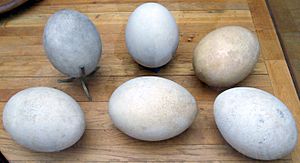
Scientists have found bones of adult Aepyornis birds and also their eggs. These eggs are the largest bird eggs ever found! They could be up to 34 cm (13 in) long and weighed about 10 kg (22 lb). Imagine, one elephant bird egg was about 160 times bigger than a chicken egg!
Sometimes, whole fossilized eggs are discovered. Many museums around the world have these amazing eggs on display. For example, the National Geographic Society has one that even contains the skeleton of an unhatched bird. The famous naturalist David Attenborough once pieced together an almost complete eggshell from fragments he found.
The Name "Elephant Bird"
The name "elephant bird" comes from an old story. It seems to have started with Marco Polo in 1298. He wrote about a mythical bird called the rukh. He described it as an eagle-like bird strong enough to "seize an elephant with its talons." Even though elephant birds couldn't fly, sailors might have seen their huge eggs and thought they belonged to a giant flying bird from Madagascar.
Another idea is that the legend of the roc might have come from sightings of a very large ancient eagle that lived in Madagascar. This eagle was big enough to carry away large lemurs. Lemurs still have a fear of flying predators today.
The ancient name for the bird in the Malagasy language was vorompatra. This means "bird of the Ampatres," which is now known as the Androy region in southern Madagascar.
Where Did Elephant Birds Come From?
Elephant birds, like ostriches, rheas, cassowaries, emus, kiwis, and the extinct moa, were all ratites. This means they couldn't fly, and their breast bones were flat, without a keel (a ridge that flying birds use to attach strong flight muscles).
For a long time, scientists thought that elephant birds became flightless and giant in Madagascar itself. This was because Madagascar and Africa separated a very long time ago, before ratites appeared.
However, newer studies looking at DNA show something surprising! The closest living relatives of elephant birds are actually the New Zealand kiwis. This suggests that the ancestors of elephant birds flew across the Indian Ocean to Madagascar long after the supercontinent Gondwana broke apart. There's even evidence of ancient flying ratites, like Proapteryx, which supports the idea that their ancestors could fly.
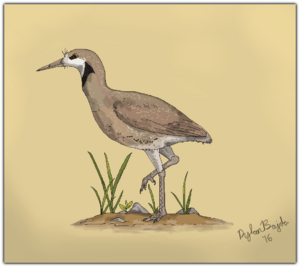
Sometimes, people have claimed to find elephant bird egg remains on the Canary Islands. If true, this would be a big mystery because these islands were not connected to Africa or Madagascar when elephant birds lived. But today, most scientists believe these eggshells belong to other extinct North African birds, not elephant birds.
Interestingly, two whole elephant bird eggs have been found in Western Australia. Scientists think these eggs might have floated all the way from Madagascar to Australia on ocean currents. This has happened with other bird eggs, like penguin eggs from the Kerguelen Islands washing ashore in Australia.
How Elephant Birds Lived
Diet
We don't have many fossils from Madagascar's rainforests, so it's hard to know for sure if some elephant bird species lived in dense forests, like the cassowary does today. However, some rainforest fruits with very hard seeds might have been eaten and spread by these large birds. Some palm fruits are dark bluish-purple, just like many fruits that cassowaries eat and help to spread.
Reproduction
Elephant birds laid those incredibly large eggs we talked about earlier. These eggs were crucial for their reproduction. Sometimes, scientists find these eggs almost perfectly preserved. Many museums around the world proudly display these rare and amazing eggs, giving us a glimpse into the life cycle of these extinct giants.
Why Elephant Birds Disappeared
Most scientists believe that elephant birds became extinct because of humans. They used to live all over Madagascar. One idea is that humans hunted them to extinction very quickly. There is evidence that people hunted them and also destroyed the places where they lived. Their huge eggs might have been especially easy targets for people looking for food. Archaeological studies have found eggshell pieces near old human campfires, suggesting that families often ate these eggs.
We're not completely sure when they died out. Some stories about these giant birds might have been passed down for hundreds of years. However, we have found elephant bird bones with cut marks from tools, dated to around 120 CE. And eggshells have been dated to about 1000 CE.
Another idea is that elephant birds died out because of diseases. Humans brought domesticated animals like chickens and guineafowl to Madagascar. These animals might have carried diseases that spread to the elephant birds, which had no natural protection against them. Bones of these farm birds have been found in the same places as elephant bird remains.
Elephant Birds in Stories and Art
- The rukh, a giant mythical bird from the stories of Sindbad the Sailor in One Thousand and One Nights, is thought by some to be a distorted version of the elephant bird.
- The writer H. G. Wells wrote a short story called "Æpyornis Island" in 1894, which was about this amazing bird.
- The wildlife artist Walton Ford created a painting about the Elephant Bird called "Madagascar" in 2002.
See also
 In Spanish: Ave elefante para niños
In Spanish: Ave elefante para niños


